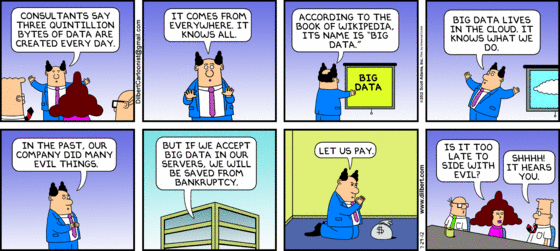
In todays hyperconnected world data is often touted as a competitive advantage. A cursory google search provides a lot of self evident truths “use big data” “Analyze, insight, execute” “Big data will revolutionize your business” , what does this really mean in practice? To gain a true competitive advantage you need to have a comprehensive data strategy which consists of both a simple and relevant mental model and the associated operational structure and processes to actually make it happen.
A good place to start is with recognizing a self evident axiom — “Data is easy to collect, hard to use”. Today’s technologies allow for very easy collection (API’s galore) and storage of data (Amazon S3 is cheap). However, gaining insight from all this data is the hard part. Your competitive advantage will be defined by how quickly you can turn this data into insights and execute on the insight — your key KPI is to reduce the “time to insight”
So whats a good, mental Model? This post specifically delves into the online lending business to provide a concrete example.
We can break down the components of the use of data in an online lending business into four core areas.
#1 Conversion funnel optimization
Strategic question: How do I use data to best convert my customers?
Classical UI/UX based strategy’s fit into this bucket. Every business has a customer acquisition funnel and the primary data goal is to measure user behavior, track usage and iterate iterate iterate on user features to increase conversion efficiency. In the online lending business, automation for the customer is the name of the game i.e how can we enable the customer to have a seamless and quick user experience. This typically involves third party integrations with data sources so that customers have to only provide a very small amount of identifying information and the platform can fill in the rest. This reduces friction and increases conversion.
#2 Decisioning
Strategic question: How do I use data to build and deploy scalable decisioning?
How to decide to extend credit or reject is the core of any lending business. There are two facets to this function.
- Model generation: How to build a good credit model? Data is the key driver, you have to gather data sources that are first party (supplied by the user) as well as third party (automated from various sources) and provide the risk team/model builders with a sandbox to build and test their credit models. In addition to the data gathering framework there has to be a robust testing framework as these models need to be tested against existing decisions as well as used to perform reject inference on past decisions.
- Model runtime: Once a model is built, how to run this model in production and make credit decisions in realtime? A good model is wasted if you cannot scale the operational aspects of its use.
#3 Portfolio monitoring
Strategic question: How do I use data to monitor my loan book of business?
Lending business live and die buy the health of the originated loan book. There are two elements to consider
- Protective: How do I measure in realtime my default exposure? You have to gather and analyze in realtime the health of your borrowers business (examples are monitoring current credit scores and new UCC filings).
- Revenue opportunity: Portfolio monitoring data can also identify the subset of your customers that are doing very well — this provides an opportunity to cross sell them other financial products to support their growth.
#4 Identity/Fraud
Strategic question: How do I use data to prevent fraud?
Every fin-tech business is concerned with fraud and identity. Data is used a key input to layer of identity and fraud solutions. This is an overlay on the every part of the platform.
They all re-enforce
These individual pieces add value in their own silos but are also self-reinforcing.
Better models leads to better decisions, better decisions lead to better targeting and user conversion. Better portfolio monitoring leads to better models and better decisioning. Better conversion optimization leads to better data for model generation. This is the self reinforcing flywheel effect.
Once you have a mental model nailed down. You still need an organizational operational structure to put this into practice.
A few good practices to follow
- Data is treated as a first class citizen. What does that mean? Data is considered in every step of the product process. It is every PM’s responsibility — at every step of the process think about good data models and instrumentation. Instrument everything.
- The entire engineering team is responsible for data instrumentation. Collection of data is everybody’s responsibility.
- Hire and staff a dedicated data engineering and data product management team. This team should solely focus on building the data infrastructure to consume all the data produced by the various parts of the platform and provide the tools to surface insights. The data team should have its own dedicated roadmap.
This post is also available on Medium